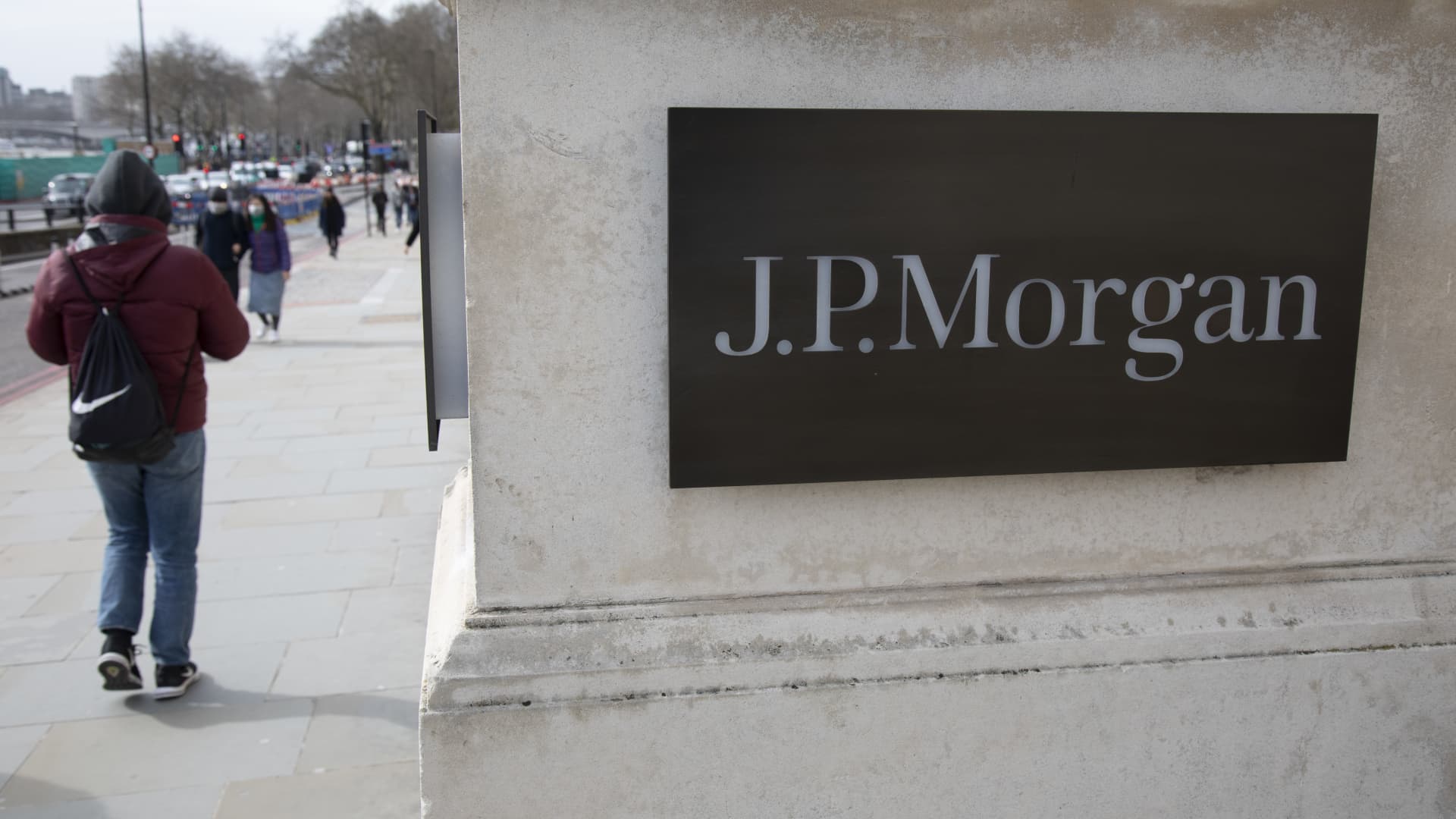Sign for J.P. Morgan on 7th March 2020 in London, United Kingdom. JPMorgan Chase & Co. is an American multinational investment bank and financial services holding company headquartered in New York.
Mike Kemp | Getty Images
LONDON – As lockdowns ease and regulatory pressures subside, some of the headwinds facing Chinese stocks are set to recede, according to JPMorgan.
Chinese markets have been beaten up over the last 15 months, as the country’s “zero-Covid” strategy and lockdowns of major cities stifled economic activity, while regulatory crackdowns placed further downward pressure on businesses, particularly domestic internet titans such as Tencent and Alibaba.
Hong Kong’s tech-heavy Hang Seng index is down around 25% over the past year, while the Shanghai Composite has dropped close to 9%.
On Monday, China markets continued to fall, caught up in fears surrounding rate hikes by the U.S. Federal Reserve after Friday’s hotter-than-expected U.S. inflation numbers. The Hang Seng slid over 3.5%, while the Shanghai Composite slipped 1.45%.
However, as China begins to reopen and Beijing signals some intent to ease its scrutiny on the tech sector amid the economic downturn, strategists are turning cautiously optimistic.
JPMorgan Asset Management’s Global Market Strategist Tilmann Galler said that efforts to reopen cities and launch vaccination campaigns indicated that Beijing had realized its “zero-Covid” strategy was unsustainable. Instead, the country looks to be transitioning to a “living with Covid” policy, he added.
China’s two largest cities, Shanghai and Beijing, loosened some Covid measures earlier last week, but imposed some additional restrictions once again on Friday.
However, speaking at the bank’s annual media event in London on Wednesday, Galler argued that while near-term uncertainties continue, key headwinds — such as its zero-Covid policy, tight fiscal policy and strict regulation — are cyclical rather than structural, meaning that China’s long-term prospects remain intact.
“Policymakers are changing their attitude and changing the direction of policy. China was tightening but now this is changing, and the central bank will play a crucial role in that,” he said.
“The People’s Bank of China – compared to other central banks in Europe and North America – they have the flexibility to be more supportive for the economy.”
China’s headline consumer price index rose by just 2.1% year-on-year in April, compared to the 7.4% seen in the euro zone for the same month, and 8.3% in the U.S.. The latter both saw further accelerations in May.
Galler suggested that as such, further monetary policy easing could be expected from the PBoC, with the benchmark rate for mortgages already having been lowered.
“Much more important also, the fiscal policy direction is changing as well. There is more government support. Now, there is more money earmarked for railway, infrastructure investment, airport investment, tax cuts, purchase incentivization for cars, for the car market that is reeling at the moment,” Galler highlighted.
Headwinds becoming tailwinds
He added that credit growth — which has historically been a positive indicator for the stock market — was showing signs of strength.
Although credit growth slipped in April, Galler suggested that this was solely down to demand destruction from the lockdowns, and would pick up again as cities like Shanghai and Beijing resume activity.
“Valuations sometimes in the short term are a terrible indicator, but it at least gives you some guidance for the long term. And although we know the short-term visibility in China is still difficult, we still believe that the long-term growth drivers for China are still valid,” Galler told journalists.
“After the stock market downturn, the P/Es (price-to-earnings ratios) in the Chinese market are now 20% below the long-term average, so a lot of bad news is already priced into Chinese equities.”
P/E ratio is a method of determining a company’s valuation by measuring its present share price in relation to its earnings-per-share.
“From that standpoint, in our view, Chinese equities are beginning to look more attractive despite the headwinds, and we need to consider that some of those headwinds are beginning to recede, and some of them even turning into tailwinds,” Galler said.
While the last 15 months have been tough on Chinese stock market investors, the country’s bond markets have outperformed their global peers.
“From that point of view, China is a good diversifier for the stock portfolio, but also for the bond portfolio, because the central bank in China has different challenges than the central banks here in Europe and the U.S.,” Galler added.
His views were compounded by Myles Bradshaw, head of global aggregate fixed income strategies at JPMorgan Asset Management, who said Chinese government debt was the most exciting pocket of global markets at the moment.
“The economy is slowing, interest rates have gone up, they haven’t eased monetary policy. It’s a great diversifier for your European, U.S. fixed income,” he added.
For all the latest World News Click Here
For the latest news and updates, follow us on Google News.

